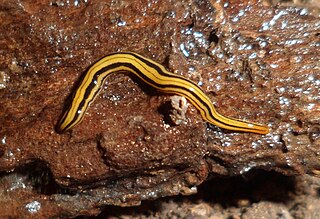
Luteostriata is a genus of land planarians from Brazil characterized by a yellow body with dark longitudinal stripes.

Obama is a genus of land planarians from South America. It contains several species adapted to human-disturbed environments, including the only invasive land planarian native to the Neotropical realm, Obama nungara, which has been accidentally introduced in Europe.

The reproductive system of planarians is broadly similar among different families, although the associated structures can vary in complexity.

Cratera is a genus of land planarians found in South America.
Cratera cuarassu is a species of land planarian belonging to the subfamily Geoplaninae. It is known from specimens found in Desengano State Park, Brazil.
Cratera joia is a species of land planarian belonging to the subfamily Geoplaninae. It is known from specimens found in Serra do Mar State Park in Brazil.
Gigantea urubambensis is a species of land planarian belonging to the subfamily Geoplaninae. It is known from specimens collected in rainforests of the Lower Urubamba River valley in Peru.
Cratera hina is a species of land planarian belonging to the subfamily Geoplaninae. It is known from specimens found in the Paranapiacaba Conservation Units Mosaic in Brazil.
Cratera taxiarcha is a species of land planarian belonging to the subfamily Geoplaninae. It is known from specimens found in Albert Löfgren State Park and Cantareira State Park in Brazil.
Cratera picuia is a species of land planarian belonging to the subfamily Geoplaninae. It is known from specimens found in Saint-Hilaire/Lange National Park in Brazil.
Cratera arucuia is a species of land planarian belonging to the subfamily Geoplaninae. It is known from specimens found in Intervales State Park in Brazil.
Cratera assu is a species of land planarian belonging to the subfamily Geoplaninae. It is known from specimens found in Serra da Bocaina National Park in Brazil.
Cratera boja is a species of land planarian belonging to the subfamily Geoplaninae. It is known from specimens found in Serra da Bocaina National Park in Brazil.
Cratera tui is a species of land planarian belonging to the subfamily Geoplaninae. It is found in Serra da Bocaina National Park and Itatiaia National Park in Brazil.
Cratera imbiri is a species of land planarian belonging to the subfamily Geoplaninae. It is known from specimens found in Campos do Jordão State Park in Brazil.
Cratera paraitinga is a species of land planarian belonging to the subfamily Geoplaninae. It is known from specimens found in the Boracéia Biological Station in Brazil.

Geoplana apua is a species of land planarian belonging to the subfamily Geoplaninae. It is found in areas within the Atlantic Forest in the municipalities of Nova Iguaçu and Teresópolis, Brazil.
Geoplana caraguatatuba is a species of land planarian belonging to the subfamily Geoplaninae. It is known from specimens found in Atlantic Forest within Caraguatatuba, Brazil.
Geoplana cananeia is a species of land planarian belonging to the subfamily Geoplaninae. It is found in areas of the Atlantic Forest on Ilha do Cardoso within Cananéia, Brazil.
Geoplana iporanga is a species of land planarian belonging to the subfamily Geoplaninae. It is found in areas of the Atlantic Forest within Intervales State Park in Brazil.




